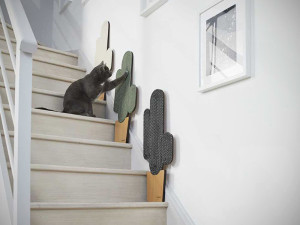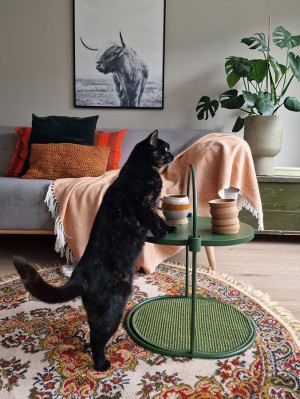How to Train and Get Your Cat to Use a Scratching Post
You can stop your cat from scratching everything in sight.

Share Article
In This Article:
Why Is a Scratching Post Good for Your Cat? How to Train and Get Your Cat to Use a Scratching Post Frequently Asked Questions
As all cat parents know, cats and young kittens have very sharp, long, retractable claws that can gouge pretty deep scratches in furniture, flooring, and skin if left unchecked. However, you can stop your cat from scratching everything in sight by utilizing a scratching post.
While many cats will use scratching posts automatically, others may need training or convincing to go to one. With our guide and the help of our expert, cat behavior consultant Joey Lusvardi, you can choose the right scratching post and convince your cat to use it regularly.
Main takeaways
Scratching posts can help prevent cats from destroying your furniture.
Cats enjoy using scratching posts for stress relief and claw maintenance.
By picking the right post and place, your cat will likely use the scratching post instinctively.
Why is a scratching post good for your cat?
You might be wondering why your cat should use a scratching post or if they even need to at all. Actually, using a scratching post is good for your cat or kitten. Lusvardi says that “scratching is a normal cat behavior and a behavioral need of cats. Scratching posts provide an outlet for this behavior so that the behavior doesn’t happen somewhere you don’t want.”

Here are some other reasons why a Scratching Post is good for your cat:
1. Natural behavior
Scratching is a natural behavior for cats because their claws are totally different from human nails. First off, cat claws come out of the front of their toes and are retractable and extremely sharp. These claws are used in the wild to catch and kill their prey, so cats scratch at home because it’s a natural instinct. Scratching also helps cats mark their territory, stretch, and keep their claws shorter. Cats will tend to scratch instinctively, but you probably don’t want them to do it on your furniture.
2. Stress relief
Scratching furniture is also a form of stress relief for cats. Cats can get stressed and anxious, and they will seek out methods of relieving their stress. Scratching helps them relieve stress, partly because it feels good and partly because marking their territory helps them feel more relaxed.
3. Communication tool
Cats also scratch to communicate to others, especially cats, about where their territory is. This works through the visual scratch marks on the objects and scents that come from the glands in the cat’s paws. By scratching on a post, your cat is leaving behind a reminder to other cats that this is their territory, even if there are no other cats in the house. This is also why you shouldn’t ever hide the scratching post — it’s better to leave it in a position in the home where your cat’s message can be heard.
4. Claw maintenance
One of the most utilitarian reasons why your cat likes to scratch is as a form of claw maintenance. Claws aren’t like human nails, and they grow outwards like the rings of a tree. The new claw is in the center, and the nail around the edge gets thicker and dies. If your cat scratches properly, they will work this dead sheath off to expose the nice new claw underneath. The scratching post is the best way to make this happen.
How to train and get your cat to use a scratching post
If you want to get your cat to use a scratching post instead of your furniture and clothes, it’s important to train them and make the right choices. Lusvardi says that you should “focus on encouraging your cat to use a scratching post and not on stopping them from scratching your furniture.” You can do this in the following ways:
1. Pick the right place
One of the most important considerations when trying to train your cat to use a scratching post is placement. Once you have chosen the right scratching post for your cat, you need to choose where to put it.
It’s important to put a scratching post in a place that is right for your cat, not just for you. It should be somewhere visible and easy to access. The scratching post should be a replacement for anything that your cat already loves to scratch. For example, if they love to scratch part of the carpet, that could be a good spot. If they tend to scratch the furniture, you can put the post in front of the couch.
Eventually, once your cat loves the post, you can try moving it somewhere that’s more convenient for you. You could also consider multiple posts.
2. Get their attention
Once the post is set up in the right place, you need to get your cat interested in it. You can try to draw their attention to the scratching post in lots of ways, such as by placing it in different spots, putting it near their food, laying it on its side, and drawing their eyeline to it. However, you should never put their paws directly onto the scratching post. There are lots of other ways to try and get their attention.
3. Use positive reinforcement
When training a cat to use the scratching post (or do anything), use only positive reinforcement, such as kind words and treats, to tell them that they’re being good and that using the scratching post is the right thing to do.
4. Make your furniture unappealing
Your cat scratches your furniture because it feels good to them and because they’re used to doing it. While offering them a scratching post will help, you also need to distract them from scratching your furniture. You can spray repellent onto the furniture, which will make it less attractive to scratch, and you can also try putting blankets on your furniture that will be less fun to scratch than the texture of your couch.
5. Provide options
If your cat isn’t taking to the scratching post immediately, you can try offering them different options. Maybe they’ll get along better with a scratching mat on the floor, a tall post in the middle of the room, or a shorter post positioned near the furniture. You need to try different options to see which one they like the most.
6. Tempt them with treats
If you’re trying to convince your cat to use the scratching post, you can try tempting them with treats. You can put catnip onto the post itself or wave treats near the post to get them to put their paws on the post and scratch it on their own terms. If your cat is very food-motivated, this could be the best option.
7. Train them to use it with toys
If you’re trying to get your cat to use the scratching post more regularly and they are very playful and toy-motivated, you can try using toys to get them to scratch. By waving a wand toy around the scratching post, you can convince your cat to play around and take notice of the scratching post. They may then also just start scratching of their own accord as part of the game.
FAQs
Why won't my cat use a scratching post?
If your cat won’t use their scratching post, don’t worry – there are many potential reasons for their disinterest. The scratching post could be in the wrong place, it might be too short, or they could just not be as into scratching as you expected them to be. Lusvardi says that step one is looking at the post itself: “Is it big enough, or is it a material your cat likes to scratch? Many of my destructive scratching cases are simply someone buying a product that is marketed toward humans and not something cats like using.”
What can I spray to get my cat to use a scratching post?
If you want to train your cat to use a scratching post, you can use a scratch repellent or anti-scratch spray on the other furniture that you don’t want them to scratch, making the scratching post the more attractive option.
Do you have to train a cat to use a scratching post?
Not all cats need to be trained to use a scratching post because their instinct is to scratch and maintain their claws. However, they may need some convincing or positive reinforcement to choose it over your furniture.

Marianne Eloise
Marianne Eloise’s work has appeared in The New York Times, The Guardian, The Cut, Vulture, and more. She is also the author of an essay collection Obsessive, Intrusive, Magical Thinkingopens in new tab. She has been going on adventures with her dog Bowie since she was 17.
Related articles
![Grey cat sitting on on stairs scratching at the cactus shaped Meyou Paris Vegas Scratcher]()
The Best Cat Scratching Posts, Pads, and Everything in Between
Save your sofa.
Why Does My Cat Scratch the Wall?
Well, that is a little unsettling.
![Kitten scratching fabric sofa]()
How to Stop Your Cat From Absolutely Ripping Apart Your Couch
Placing a cat tree or post in a room only, uh, scratches the surface of solving this problem.
![Cat scratching a couch in the living room.]()
Having This In Your Home Will Make Your Cat Scratch More, New Study Says
Plus, how to keep your kitty from destroying the couch.
![Makesure cat scratching post]()
Have You Ever Seen a Chicer Scratching Post?
Finally, a scratching post that actually looks nice in your home.
![Woman lies on carpet with orange cat.]()
Best Carpet For Cats—Durable and Scratch-Proof Options
Options that won’t become a hiding place for those big, yucky wads of fur.








